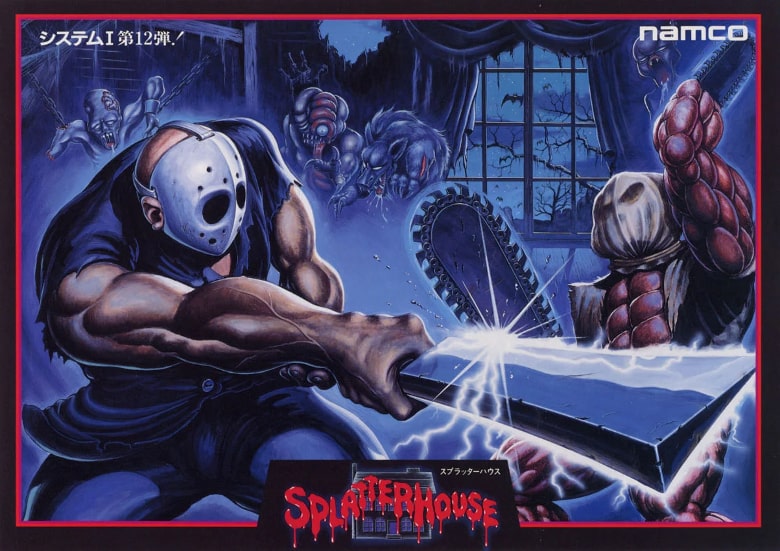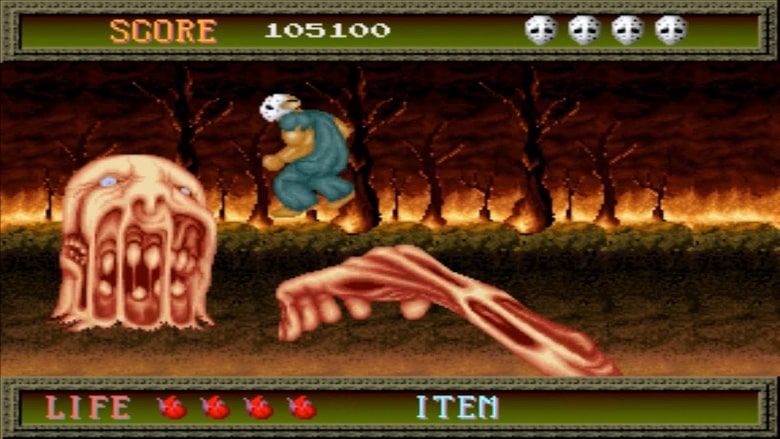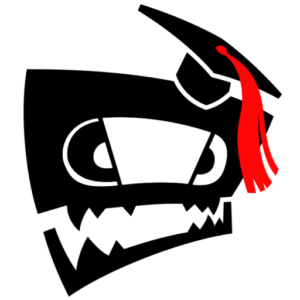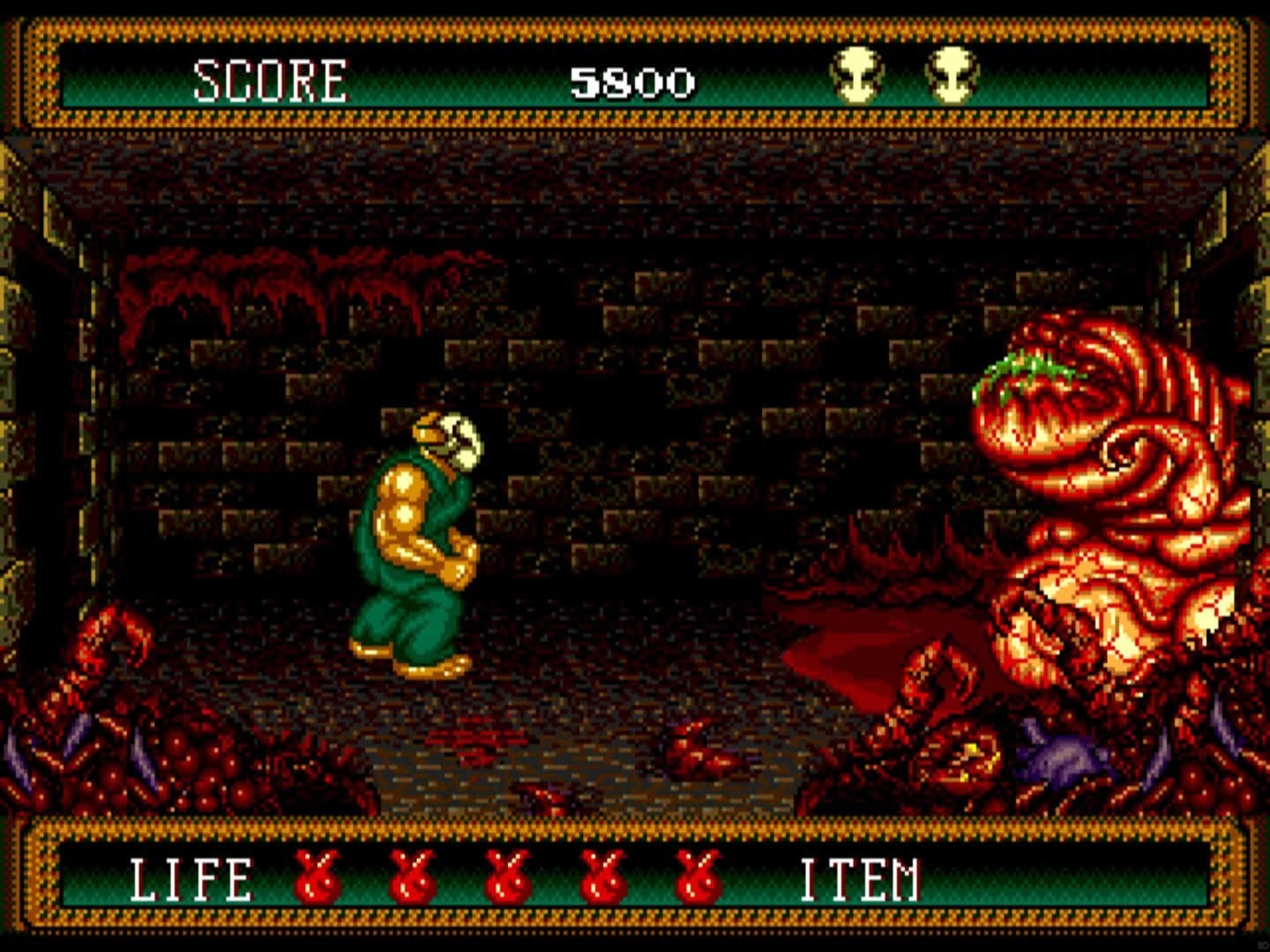Before there was a video game content rating system, the creators of Dig Dug and Galaga were blazing trails with a different kind of game dripping with graphic content. In the late 80’s, Namco unleashed the gore-fest Splatterhouse arcade game. With this, they successfully set the cornerstone for the future of horror gaming and on-screen violence.
“May be inappropriate for young children…and cowards.”
While horror games had been churned out for years on home computers and consoles, scarier aspects were left to the player’s imagination. The depictions of violence and gore in gaming had a very limited scope. That is until the Japanese game developer, Namco, decided to push arcade boundaries as well as break their own mold.
Namco was best known, at the time, for the creation of cute and cartoony games like Pac-Man and Mappy. In November of 1988, under the direction of Shigeru Yokoyama, the Splatterhouse arcade game was released. Influenced by popular Western slasher cinema and parental outrage, Namco was counting on shock factor to bring players to the joystick.

Unlike other side-scrolling brawler games, Splatterhouse was hyper-focused on detailed gore and graphic violence. Purposely drawing attention to the gruesome content resulted in the arcade cabinet’s immediate success in Japan and Europe. A slower cult following developed in the United States, as Splatterhouse wasn’t widely distributed to Western arcades. Lore surrounding the game claims its content stirred controversy, resulting in a ban. Others believe it was a copyright infringement that brought on the ban. Home ports that followed for TurboGrafx-16 and MegaDrive would bring a censored version to wider audiences with toned down splatter and character changes.
Gameplay of the Original Splatterhouse Arcade Game
The original Splatterhouse arcade game didn’t offer much of a backstory, only presenting the player with an opening sequence of two figures seeking shelter from a rainstorm in a dark mansion. It would be 1990’s home port that would expand on the game’s plot.
In the instruction manual, the figures running through the woods are identified as Rick and Jennifer, college sweethearts and parapsychology students that have traveled to West Mansion for a research project. The West Mansion is locally known as “Splatterhouse,” rumored to contain mutated abominations created in a lab by the homeowner, Dr. Henry West.
As they enter the mansion and the door slams behind them, Jennifer screams bloody murder and a game over screen appears. But death is only the beginning. Rick awakens from his own unknown demise in a dungeon, resurrected by the “Terror Mask,” an ancient artifact containing a spirit that grants super-human strength to whomever puts it on. Attaching itself to Rick, he is transformed into a rampaging monster out to save Jennifer and take revenge on West Mansion.
A two-page advertisement for the Turbo-Grafx 16 port was released as a mini comic of Splatterhouse’s origins. It featured Rick and Jennifer entering the West Mansion and being attacked, as well as the Terror Mask fusing with our anti-hero.
A Real Video Game Nasty
For any fan of contemporary slasher figures and horror cinema, the main appeal of the Splatterhouse arcade game is guessing who is who. It is a game within a game of spotting all the references in weapons, enemies, and backgrounds.
Most are quick to point out the resemblance of Rick’s mask to Jason Voorhees in the Friday the 13th franchise. Beyond the beloved horror icons of the 80s, the concept of a haunted mask hadn’t yet found its true voice. One of the first horror film entries is the 1965 Japanese supernatural drama, Onibaba. A lost samurai passes on the curse of a jealous demoness with the use of a Hannya mask. Almost 2 decades later we would be reintroduced to mask horror with a disconnected sequel to John Carpenter’s best-known movie. Halloween III: Season of The Witch’s plot was a collision between tech and the occult at the Silver Shamrock mask factory. Italy would step up to the under used trope in 1985 with Lamberto Bava’s Dèmoni, giving audiences a plague of demonic possession when an ancient mask is tied in with a horror movie promotion.
The second most notable horror reference in the franchise is our villain, Dr. Henry West. Highly regarded in the parapsychology community as a brilliant man, his secretive experiments within his mansion have unleashed Lovecraftian horrors on the world. He was a direct homage to H.P.’s 1922 novelette Herbert West-Reanimator and the 1985 horror comedy film that followed. But it is Lovecraft’s obsession with old dark houses that gives the Splatterhouse arcade game its namesake. Short stories such as From Beyond, The Dreams in the Witch-House, and The Shunned House all offer a residence where either mad science or occult ritual take place, creating massive rifts of trauma that transform the very structure into a living abomination itself. Splatterhouse’s West Mansion is not only filled with hideous monstrosities, but it actually births them into reality.
Several other horror films of the 80s are thought to have lent inspiration to the bad guys that come for Rick. Deadly Spawn slugs and Poltergeist mirror reflections are mixed in with xenomorph chest bursting and Cronenbergian fetus mutants. The chainsaw-armed boss called “Biggyman” could have borrowed again from Jason on Friday the 13th II, with a burlap bag over his head. Or it might have been a reference to the Phantom in The Town That Dreaded Sundown.

The majority of the Splatterhouse arcade game’s tributes fall under 1987’s Evil Dead II. The final act of Stage II is an entire room and its contents shuddering at the presence of Rick, attacked by flying furniture and squaring off with a hung portrait flapping about. Stage V gives you pools of sentient severed hands crawling about and a few giving the finger. But it is the moment when Rick encounters Jennifer laid out on a sofa that leads me to emphasize Evil Dead II. She awakens to transform into a hideous monstrosity that reminds me of Ted Raimi as a Deadite Granny. Rick has no choice but to kill his own girlfriend, in an anguished moment once shared by Ash as he chainsawed Linda.
“It begins again…!”
The success of the Splatterhouse arcade game in Japan was followed in 1989 with the first and lesser-known sequel of the franchise. Splatterhouse: Wanpaku Graffiti was a Japanese exclusive for the Famicom system. More of a cutesy parody of the original, the graphic violence was removed and it was marketed to a younger audience. Wanpaku Graffiti deviated from the original storyline and featured even more horror pop-culture references that made the game downright silly at times. Fans continue to debate whether or not it was intended to be a prequel to the original game.
— FOUNDATIONS OF HORROR —
Further explore these subgenres & tropes. more>>
#Action horror | #Slasher horror | #Monster horror | #Capital M Monsters

In 1992, Namco released Splatterhouse 2 for Sega Genesis. The game’s plot would pick up 3 months after the events of the Splatterhouse arcade game. It features Rick plagued with nightmares and tempted by the spirit of the Terror Mask to return to West Mansion and revive Jennifer’s soul. 1993 followed with Splatterhouse 3 on Sega, with the disruption of happily ever after. Rick and Jennifer are now married with a child as Dr. West’s horrors once again invade their lives.
2010’s Splatterhouse is a retelling of the original story for X360 and PS3, updating the 16-bit world to a modern-day bloodbath that is packed with horror reference easter eggs. Following in the arcade cabinet’s footsteps of valuing blood n’ guts over gameplay, the reboot is incredibly entertaining for a gore-hound. In fact, the entire franchise is highly recommended to fans of retro horror gaming, if for nothing else than the nods to hack n’ slash cinema throughout each installment.
A Putrid Pioneer of Horror Gaming
It may not have been the first horror game, but the Splatterhouse arcade game reshaped the genre. It gave the player the opportunity to be a Jason Voorhees knock-off that punches bats and chops levitating heads with a medieval axe. Namco reached new audiences with gruesomely detailed carnage and solid Eldritch elements, a formula still prevalent in modern horror games. Without Splatterhouse we may have never gotten Friday the 13th: The Game for PS4 and Xbox One.
In a 1989 Splatterhouse review in Computers and Video Games magazine, “If coin-ops could give out smells, this one would reek of an abattoir.”
Last Updated on May 15, 2023.

